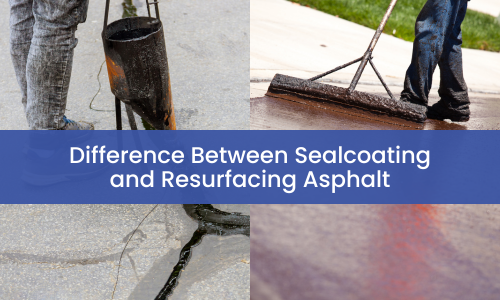Although both processes are essential to maintaining asphalt pavement, there are major differences between sealcoating and resurfacing asphalt. Both processes will extend the life of your pavement, improve its performance and boost its appearance, but asphalt sealcoating and resurfacing do so in different ways.
Whether it is time for a new round of asphalt sealcoat or time to resurface the pavement, an experienced asphalt contractor should be the expert to manage the project. Professional pavement installers invest in high quality asphalt maintenance products and processes, and they can guarantee their workmanship with a warranty and a commitment to doing the job properly.
What is the Difference Between Asphalt Sealcoating and Resurfacing?
Sealcoating and resurfacing have some important points in common as both will improve the asphalt’s durability, longevity, performance and curb appeal. But that is where the similarities of these processes end. Here is a closer look at the differences of asphalt sealcoating and resurfacing, and how both fit into your long-term pavement maintenance plan:
- The process – During asphalt sealcoating, a protective coat of asphalt is applied to the pavement’s surface. This can be done with spray applicators – which can be mounted to a skid – or with a set of brooms and some elbow grease. Given the scope and precision demanded during commercial asphalt projects, spray application is the preferred approach. Once the asphalt is applied, it needs to cure before it is ready.
Asphalt resurfacing is a much more extensive process. First, the existing pavement surface is removed – typically with asphalt milling machines, pulverizers and extractors. This failed asphalt can be repurposed as an ingredient in new asphalt, so it is recovered and reused if possible. Once the existing surface is removed, any underlying base failures will be resolved and a new surface course of asphalt is overlaid on the deeper layers of pavement still present.
- The benefits – Asphalt sealcoating acts like a layer of protective wax or a membrane that provides modest but significant durability, performance and aesthetic benefits. Asphalt sealcoat binds the surface aggregates together like glue, protecting against aggregate loss and preventing water from penetrating the pavement’s surface. Asphalt sealcoat also protects against UV damage, promotes a smoother driving experience and restores the pavement’s rich, dark appearance that people associate with new asphalt.
Asphalt resurfacing is recommended when the pavement has sustained considerable surface damage or when the asphalt has reached middle age, so to speak. Resurfacing projects greatly extend the asphalt’s life by addressing any underlying causes of damage and by restoring the pavement’s surface performance and appearance. Whereas asphalt sealcoating keeps the pavement in good condition, resurfacing restores the pavement’s condition even if signs of wear and damage are present.
- Recommended timelines – Asphalt sealcoating is applied shortly after the pavement is initially installed and is recommended every 12-24 months thereafter, depending on how much traffic and wear the asphalt receives.
Asphalt resurfacing is only needed when the asphalt’s condition indicates the need for it, so timelines can vary greatly depending on how much traffic the pavement receives and how well the pavement has been maintained over the years. However, in general asphalt resurfacing is recommended every 10-15 years, which is around the halfway point, as you should expect 20 or more years from a quality asphalt paving project.
- Signs that maintenance is needed – If your asphalt has faded to a light gray instead of black, that is a tell-tale sign that it has been too long since your last sealcoat application. Minor aggregate loss and minor cracks are also initial signs of wear that sealcoating may help slow.
Asphalt resurfacing is only recommended when the pavement is showing noticeable signs of damage or wear. If your pavement has widespread surface cracking or warping, if there are several potholes or if the asphalt is subsiding in spots, deeper repair and resurfacing work will be required.
- Cost and project time – For a commercial asphalt sealcoating project, property owners should expect to pay somewhere around $.20 per square foot, and the process typically takes a single afternoon to complete. Once the asphalt sealcoat is applied, it will need 24-72 hours to completely cure and be ready for traffic.
Asphalt resurfacing projects are much more involved and cost more in terms of money and time. Costs vary greatly depending on several factors (project size, additional repair services, etc.), but anywhere between $5-10 per square foot is normal for a resurfacing project. Time to completion is also highly subjective and highly dependent on the pavement’s condition, but plan on the project taking several days or more.
What Asphalt Sealcoating and Resurfacing Have in Common
Sealcoating and resurfacing are essential maintenance routines for every patch of asphalt, no matter where it is installed or how heavily it is used. Although they serve in different roles for a property owner, both asphalt resurfacing and sealcoating should be trusted to an experienced pavement team. The asphalt professionals can guarantee excellent work quality and ensure your pavement maintenance extends the asphalt’s useful life and the value it provides to your organization.
- Which Season is Best for Asphalt Paving in Houston? - March 28, 2025
- Questions to Ask a Foundation Contractor Before Hiring - March 21, 2025
- What is Land Clearing? - March 14, 2025

